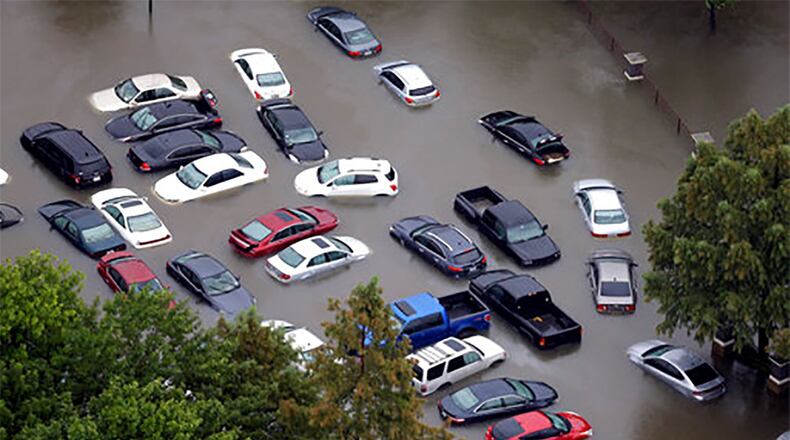State Farm, one of the largest U.S. auto insurers, says it has already received almost 20,000 claims from the Houston area.
Cars sat in water for days, in many cases up to the windows or roof lines. It’s likely they’ll never be driven again.
Here are answers to questions about what will happen to those vehicles and how to handle your car in the aftermath of the epic storm.
Q: Should I start my car if it’s been flooded?
A: No, in almost all cases. If the car was only in a few inches of water that didn't rise past the bottom of the body, maybe. Water higher than that can get into wires, transmission parts, the exhaust or other places. Deeper water could enter the cylinders that surround the pistons. Trying to start the car could bend parts that connect the pistons to the rest of the drivetrain, said John Nielsen, managing director of automotive engineering for AAA. Oil, gasoline, antifreeze, brake fluid and other liquids could have water in them that could cause damage if not replaced. Nielsen recommends having the car towed to a mechanic for inspection. Depending on the severity of flood damage, he says the cost of refurbishing a car likely will be more than replacing it.
Q: If it’s repaired, will my car be safe?
A: Probably not. Water could have damaged sensors, electrical connectors, computer chips and wiring that are under the carpet, behind the dashboard or in the engine compartment. That could disable lights, air bags, ignition, gas and brake pedal sensors or other essential systems. Corrosion can form beneath wiring insulation. Salty water from the Gulf of Mexico would make that worse. Damage may not surface for years. "Maybe it's OK. Maybe it's not. I would be really worried about it," says Nielsen.
Q: Will insurance cover a flooded car?
A: Depends on your coverage. If you're financing or leasing, your lender likely requires comprehensive insurance, which typically covers flood damage along with fire, vandalism or falling objects. But if you own a car outright, or it's old and would be more expensive to repair than it's worth, you may choose not to get comprehensive coverage. As of 2013, 78 percent of U.S. insured drivers had comprehensive coverage, according to the Insurance Information Institute.
Q: How do insurers handle flooded cars?
A: Once an owner files a claim, the insurer will evaluate the damage. Many states have guidelines for a vehicle to be considered a total loss, including the extent and type of damage and the cost of repair, says Missy Dundov, a spokeswoman for State Farm. If the insurer determines the vehicle is a total loss, it will pay the owner — minus a deductible that's typically $500 to $1,000 — and take the vehicle and the title.
Q: Where do flooded cars go?
A: Insurers will turn the cars over to auctions or salvage yards. Undamaged parts will be salvaged and many vehicles will be scrapped. Some will go to salvage auctions, says Tim West, vice president and North American auction director for Black Book, a service that calculates used car prices. Everything that's ruled a total loss by an insurance company should get a salvage title. But consumers should be careful. A vehicle considered a total loss in one state might not require a salvage title in another state, says Ron Montoya, a senior consumer advice editor for Edmunds.com.
Q: How can i avoid buying a flood-damaged vehicle?
A: Flooded cars could be shipped to other parts of the country or even other nations. To find out where the car came from and if it has a salvage title, experts suggest keying the vehicle identification number into services (there's a charge) that search car histories such as Autocheck or Carfax. Carfax and the National Insurance Crime Bureau offer free services to check for flood damage. Buyers can ask to take the car to a mechanic for inspection. Buyers can also look for signs of flooding, including musty or moldy odors or overpowering use of air freshener, discolored carpet or new carpet in an old car, water lines in the engine compartment or trunk, fogging inside headlights or taillights, rust or flaking metal under the car, and dirt buildup in unusual areas such as around seat tracks. If you see any signs, don't buy the car, AAA's Nielsen says. "You're liable to face gremlins with that car forever," he said.
About the Author
